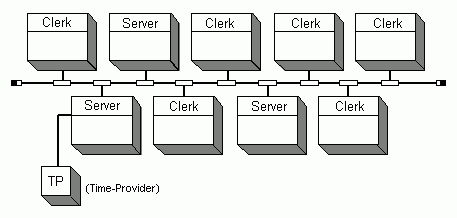Configuring DTS for a LAN
If your nodes are in a single local area network, regardless of the number of nodes, planning your DTS implementation is relatively simple. To detect faulty time servers, configure at least three systems as servers. If you want to provide redundancy for your DTS implementation, plan to install four or more servers in the network. That way, if one of the servers fails, DTS can still synchronize with reliable results.
To ensure the reliability of your DTS implementation, make sure that the network connections between server nodes are stable. If you plan to add WAN links to your LAN, do not move the servers to the remote nodes, since WAN links are usually less reliable than the LAN.
If you have a single LAN, the location of the servers on the LAN is not critical. You can locate one of the servers on a readily accessible node to aid in troubleshooting, but there are no other recommended server locations. Neither global servers nor couriers are required.
If you are planning to use one or more time-providers, locate them at easily accessible systems to ease startup and maintenance. If your network only requires synchronized clocks, but does not need to closely follow a time standard such as UTC, you may not require a time-provider. If you do not use a time-provider, we recommend that you use the DCE control program's (dcecp) clock set command to manually set the time approximately once each week.
The following figure shows a simplified LAN configuration. Your LAN may be much larger, but the figure should resemble a portion of your network.
DTS Configuration - LAN
